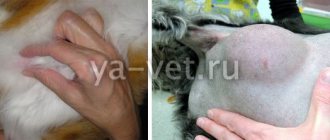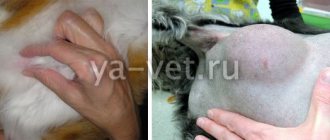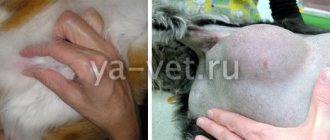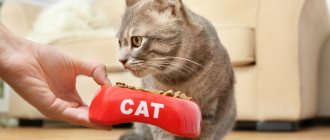Sometimes owners, when they discover lumps on a cat’s belly, try to treat the animal themselves, but this is not possible. Some formations under the skin are not dangerous, but there are also dangerous ones, so self-therapy can worsen the situation. Let's find out what can cause a lump in a cat and how to act in such a situation.
The main reasons for the appearance of lumps on the stomach of cats
The causes of a lump under the skin in a cat can be harmless. These include:
- Small balls that form after an injection. They do not pose any danger, since without any treatment they resolve on their own over time.
- Consequences of a wasp or other insect bite.
- Mats on wool. Of course, it’s difficult to mistake them for a bump, but this option also happens.
However, there are more serious types of formations. If after the appearance of one bump new ones begin to appear, then this can be a very bad sign. It is likely that this is a malignant formation. But there is no need to rush with premature species.
Hygroma
Or a synovial cyst is a swelling of tissue with saturation with serous fluid.
It looks like a painless swelling with fluid inside, but if an infection joins it, ulcerations and discharge appear. And when it grows to a large size, it can interfere and hurt when moving.
The veterinarian may prescribe removal of the contents of the cyst and the introduction of anti-inflammatory drugs in its place, but surgery is rare.
Types of subcutaneous formations and their symptoms
| Name of education | Type of education |
| Breast cancer | A malignant disease. Very often the prognosis is unfavorable |
| Lipoma (wen) | The tumor is benign and has the ability to spread |
| Skin formations | Depending on the type, they are divided into benign and malignant. These include papillomas, fibromas, sarcomas |
| Inflammatory process in the lymph nodes | The cause is inflammation of the lymph node |
| Hernia | It can be localized in the groin, navel, and perineum. Internal organs protrude under the skin |
| Inflammation of the mammary glands | Purulent process in the mammary glands |
| Complication after surgery | Often manifests itself in the form of a hernia. Cause of improper stitching |
| Skin diseases | Formation of follicles, carbuncles, purulent abscess |
So, there can be many reasons why a lump appears under the skin. And this is not uncommon for cats. But the nature of such education can be very different.
Benign
If a pet develops a benign lump, there will be no changes in behavior or eating habits. The animal does not experience any painful sensations, and the formation itself is soft if you touch it.
- Syringoepithelioma. Appears in the abdominal area in the form of a lump. The cause of formation is a violation of the activity of the sweat glands. Does not cause pain and does not grow.
- Wen (lipoma). Can vary in size and is formed from fat reserves. Has no tendency to metastasize. If it begins to cause concern to the animal, it is removed through surgery.
- In most cases, hemangioma is a congenital disease. The place of formation is the blood vessels located under the skin.
- Benign formations in the prostate area in uncastrated cats that do not live a natural life are common. Adenoma is a growth in the form of nodules that can be compared in appearance to cauliflower. Localization may vary. The disease has a likelihood of degenerating into oncology.
Benign formations can pose a danger to the animal. So a “harmless” lipoma can cause lameness or suffocation in a cat. Therefore, they cannot be left without attention.
Malignant
They have several alarming manifestations. Very often the skin in the place where the lump forms becomes hot. Over time, it begins to grow, and the cat begins to show signs of malaise (loose stools, nausea, fever). The appearance of ulcers and purulent discharge from the lump should be especially alarming. There are quite a few types of such tumors.
Others
There are other types of neoplasms. These include:
- Cysts. They are a round ball with watery contents. The boundaries of education are clear. The animal does not experience any pain. However, they can increase in size and reach larger sizes over time.
- Inflammatory process in the paraanal glands. It appears in the form of balls located under the skin. Interferes with the activity of the excretory organs. The disease is inflammatory in nature, the animal cannot relieve itself, and the activity of the secretory glands is disrupted. Outwardly, it is easily confused with a hernia, but it can increase in size depending on the position of the animal’s body.
- Eosinophilic granuloma. It appears as a red formation on the skin. Has a tendency to quickly spread to tissues located in the vicinity. It looks like a wet wound affected by microorganisms.
Mastitis
It is a consequence of early weaning from a nursing mother, sometimes - diseases of the genital organs, damage to the nipples or false pregnancy.
The mammary glands become inflamed and swollen, become hard and hot, and the body temperature rises. This is what a Sphynx cat looks like:
If a nursing female is sick, milk may not be released or will come along with pus. The doctor, after the necessary tests, will make sure that there is no cancer and will prescribe treatment.
If the illness is mild, he will prescribe compresses and massages at home; if it is severe, he will prescribe medications, including antibiotics, or even surgery.
Mastopathy in cats
Mastopathy in cats
It is a benign formation in the mammary glands of cats. As the formations progress, they can degenerate into oncology. The disease leads to a deterioration in the pet’s well-being. It responds well to treatment in the initial stage.
Causes
Most often, the cause of the pathology is a hormonal imbalance. The trigger can be pregnancy, including false pregnancy, various gynecological diseases, mammary gland injuries, abortion in cats.
Forms of the disease
There are several types of the disease.
- In the diffuse form, small nodules of connective tissue are formed;
- The nodular form is manifested by the appearance of foci of compaction;
- In the mixed form, cysts and a process in the form of fibrosis are formed.
In addition, there are several stages of the disease. Depending on the characteristics of the course.
Symptoms
The first signs of the disease very often go unnoticed. However, you may notice changes in the animal's behavior. It loses its appetite, becomes lethargic, constantly licks its nipples, and aggression may appear for no apparent reason.
As the disease progresses, nodules begin to form in the cavity of the mammary glands, and the mammary glands themselves become painful. Gradually, the process invades the lymph nodes; discharge may appear in the form of a cheesy mass, in which blood and pus are present. The animal refuses to feed the kittens and meows.
Diagnosis of pathology
If you suspect, you should show your pet to a specialist. The diagnosis is made by examination by palpation. In addition, tests and a number of examinations, for example, ultrasound, are prescribed. To clarify the nature of the formations, a biopsy is performed.
Treatment and prevention
At the initial stage, treatment is carried out at home. If this is a recently lambed cat, then it is transferred to dry food and the amount of water is reduced. Kittens are transferred to artificial feeding. The doctor prescribes drug therapy and necessary manipulations. Severe forms are treated surgically. The danger of the disease is that in an advanced stage it develops into oncology.
The method of prevention is regular examination of the animal, protecting it from injury, as well as timely treatment of concomitant diseases.
How to recognize a wen in an animal
Steatoma differs from other neoplasias in its slow growth and the presence of clear contours. It is mobile and painless. Upon palpation, it is discovered that the seal is not fused to the skin and deep tissues and has a soft dough-like consistency.
Often, palpation reveals fluctuation (a feeling of oscillation), which can be confused with an abscess. If the neoplasm is not burdened by pathological changes, then no subjective sensations are observed in the animal.
However, large growths can lead to changes in the functioning of internal organs and the occurrence of diseases. Sometimes dense areas alternate with soft ones, which also leads to incorrect diagnosis.
An important sign of fat formation is the presence of lobules. The skin in this area does not change color, sometimes it can acquire a yellowish-brown tint.
Clinical signs of lipoma
The location of the cones varies, but if they are located in a vital area, they can pose a serious threat to the health of the animal.
The appearance in the neck area makes breathing difficult, which causes hypoxia to develop. The animal shows signs of depression of the cerebral cortex.
It is noted that:
- lethargic sleepy state
- lethargy
- nausea, vomiting
- urinary and fecal incontinence
If there is a lipoma in the head area, neurological disorders may occur due to compression of the vessels supplying the brain.
The animal is observed:
- change of consciousness
- impaired movement coordination
- convulsions
Severe brain hypoxia leads to the death of the pet.
Lipomas on the paws or armpits lead to lameness and changes in gait.
Breast cancer in cats
One of the causes of mammary gland cancer in cats is advanced mastopathy. Most often diagnosed in older animals. In rare cases it occurs in cats, however, it has its own specifics. There are several types of cancer in cats.
Causes
As already mentioned, one of the reasons for the development of oncology in cats is advanced mastopathy. Cats develop intraepithelial cancer. The process develops due to the degeneration of epithelial or connective tissue cells. Depending on the type of cells that served as the “building material,” several types of cancer are distinguished.
Tumor stages
There are 4 stages of the disease. In the initial stages, the tumor is small. Therefore, very often the disease is not detected immediately. At stages 1 and 2, the animal eats normally, behaves actively, and does not show signs of anxiety. At the initial stage, the lump in the chest is no more than 1 cm. Closer to the second stage, its size can reach 3 cm.
The third stage is manifested by a significant increase in tumor size. It can already reach 5 cm. At the same time, the process of metastases begins. The lump changes a lot. Ulcers and wounds with bloody discharge may form on it.
The last stage is manifested by the active process of metastasis formation, as well as tumor disintegration. It can open and release contents with an unpleasant odor. In addition, the animal sharply loses weight, loses its appetite, and quickly weakens.
Clinical signs
It is not always possible to suspect the development of the disease from them:
- Slight increase in temperature;
- Bloody discharge appears;
- Ulcers and wounds may appear on the surface of the tumor;
- The animal experiences pain in the mammary glands;
- Rapid weight loss and lack of appetite are alarming signs;
- Minor lumps can be found under the skin.
Treatment methods
First of all, the cat undergoes surgery to remove the tumor. Often together with the affected organ. After this, chemotherapy is prescribed. It is worth remembering that a pet has the greatest chance of survival only at the initial stage. In a neglected state, it is doomed to death.
Prevention measures
According to experts, the only method of prevention is sterilization. After the very first heat. The animal should be examined regularly, and after 10 years of age, show it to a doctor.
Cancerous degeneration of the mammary glands
Let's start with the most terrible diagnosis. How can you avoid a sad outcome? It has long been known: if you detect trouble at the very beginning!
Breast cancer is recognized by this sign: the tumor grows quickly, and there is usually more than one of it, because “trouble never comes alone”: the number of smaller swellings also increases quickly, and the localization sites at first are near the nipples closer to the groin.
These warning signs are a reason to run to the vet!
Then the bumps become dense, bleeding, painful, with a purple-pink tint. The photo shows a severe case, but don’t worry, it can be eliminated:
Since at the beginning of the disease the cat’s health is normal, as the disease progresses, it will begin to lose weight and lose appetite, and this is the second threatening “marker”! Therefore, in order not to start a tumor, to successfully get rid of it and thereby save the life (!) of your pet, you need to examine and feel its body more often in order to see a doctor early.
The photo shows the view after a successful operation:
Treatment, even in an advanced form, sometimes (but not always!) helps to prolong life by several months and reduce discomfort in this condition.
At risk are older and unsterilized animals (who are given “Sex Barrier” and all other anti-estrus drugs, the instructions for which always (!) contain a warning about the danger of oncology, even from several uses - from 1 to 3 times!).
Veterinarian advice: you need to sterilize your ward at 11-12 months, when the genitourinary system has formed, or between the first and second estrus, first having received the necessary vaccinations, and from the age of 6 - regular examination in the form of medical examination for early diagnosis of cancer, if it decides to start in your tail!
Other possible causes of belly bumps
Not in all cases, the cause of the appearance of lumps is oncology. These formations can be caused by inflammatory skin diseases and various types of hernias.
Inflammation of the skin
Bumps on the skin due to inflammatory diseases may vary in size.
Wen (lipomas)
Formed in the fatty layer of the skin. It is a round formation, sometimes in the form of an oval. When palpated, it rolls. It does not cause metastases, however, it has the ability to grow. May pose a danger to the animal depending on its location.
Hernias
May have different sizes. They can be as small as a pea in size. The most common area is the umbilical area, and can form in the groin. Lead to pinching of internal organs. Requires treatment.
Abscess in cats
This lump has purulent contents. The formation process itself is accompanied by increased temperature. Hair loss occurs in the area of formation. If left untreated, the lump may rupture over time, leading to blood poisoning.
Lymphadenitis
The disease is manifested by inflammation of the lymph node. The affected node is characterized by swelling and immobility. The animal is in severe pain. The structure of the node is dense and has an oblong shape.
Ticks
A tick bite is often accompanied by an allergic reaction in the pet. It is caused by certain substances in the saliva of ticks. In response to a bite, a small bump appears on the cat’s body. The animal does not experience any painful sensations. The lump does not grow and may be itchy.
Scratches
A scratch is a damage to the skin. The affected area may become infected with germs. This leads to the development of an inflammatory process, which manifests itself as a lump. This is why scratches need to be treated, even if they seem harmless.
Mastitis
Mastitis in cats manifests itself in the form of small lumps that form on the nipples. As they grow, the size of the mammary glands increases, redness is observed, and the skin in the affected area will be hot. If treatment is not started in a timely manner, mastitis becomes a purulent process. Treatment requires antibiotics. Therefore, you will have to stop feeding kittens.
Hematomas
Bruises are manifested by minor hemorrhages under the skin. A lump often forms at the site of the injury.
Skin diseases
Various inflammatory processes often form on the surface of the skin. During the inflammatory process, a boil forms in the hair follicle. Over time, it opens and pus appears.
Carbuncle is also an inflammatory skin disease. The location can be any part of the body. May be large in size. Accompanied by the discharge of pus.
Prevention measures
If various microtraumas or bruises occur on the animal’s body, it is necessary to treat the wound, even the smallest scratch. Through an open wound, microorganisms enter the bloodstream, which can lead to inflammation, an abscess, or inflammation of the lymph nodes.
It is necessary to periodically wash the animal's fur and skin so that the pores on the cat's skin do not become clogged.
Any formation is stressful for the cat’s body and the owner’s nerves; in no case should you self-medicate, and immediately take your pet to the doctor - only the doctor will determine the type of tumor and make the correct diagnosis.
Attention to the cat’s hygiene, to changing its behavior, and timely contacting a veterinarian will save the animal from terrible diagnoses, and the owner’s nerves will be in order. Share with friends:
Diagnosis and treatment of cones
If you find bumps in your cat, you should show your pet to a specialist. It is very important to establish an accurate diagnosis of the animal in a timely manner. Treatment for the lump will depend on the diagnosis. The sooner the cause of the bump is determined, the more effective the therapy will be. If oncology is detected, remission can only be achieved by treating the disease at an early stage.
Basic and additional therapy
Therapy is prescribed depending on the diagnosis. It is aimed at eliminating the underlying disease. Purulent bumps on the body are opened in a veterinary clinic. To eliminate inflammation, a course of antibiotics is prescribed. In addition, it is necessary to treat the affected areas with antiseptic drugs. If a diagnosis of oncology is established, then therapy is chosen according to a different principle. First, the animal’s tumor is removed, then treatment is selected according to the appropriate regimen.
What to do with purulent and bleeding seals?
If a purulent seal forms, you need to show your pet to a specialist. Treatment of such a serious inflammatory process as an abscess should be carried out in a hospital setting. It is dangerous not only due to the formation of pus, but also by poisoning the cat’s body with decay products.
The abscess is opened by a doctor and treated with special solutions. The doctor places drainage tubes.
Bleeding lumps require examination in a clinic. Because it is necessary to establish the cause of their formation.
Hernia
If a cat has a lump under the skin on its stomach, this may indicate a hernia, which is localized in the groin. The formation comes in different sizes - from tiny to 5-6 cm. Sometimes it is located in one place, and sometimes it “migrates” within the groin. In this case, the lump can behave differently.
© shutterstock
In some cases, hernial tumors are very painful, while in others they do not bring any discomfort to the pet at all. The temperature of the skin over the lump may increase greatly or remain normal. The tumor itself can be hard or soft.
In any case, a hernia is serious. Therefore, the cat needs to be examined by a veterinarian and treated, which is often surgical. If the hernia is small and does not bother you, conservative measures are used. Massage, special fixing bandages, etc. are prescribed. A dangerous complication of a hernia is its strangulation. It leads to inflammatory processes in surrounding tissues.
A tumor on a cat's stomach can be of different types.
So, the formation of a tumor on a cat’s abdomen is a common occurrence. It can be benign or malignant in nature. Depending on what tissue turned out to be the “building material,” malignant tumors come in different types.
In males, a fairly rare type of cancer occurs - intraepithelial. Cancer in females also varies. It could be carcinoma. It is formed from epithelial tissue. Another type is adenocarcinoma. Its “building material” is glandular tissue.
Benign tumor
This is a lipoma (or wen). It is enclosed in a capsule, has clear boundaries and, unlike malignant tumors, does not tend to grow quickly, is round or oval, soft to the touch, and moves under the skin.
It is usually monitored, and if removed, it is only in extreme cases - for example, if it is too large, interferes with the cat's daily activities, or is itchy. Although it is not fatal, it is necessary to show it to a doctor to confirm this particular diagnosis:
How to prevent stomach tumors in cats
Unfortunately, there is no way to prevent the development of tumors. However, it is possible to keep your pet healthy for as long as possible. To do this, you need to organize the right diet for her. It does not include leftover food from the owners. The animal should be fed only with specialized food.
You can add vegetables and fruits to your diet; they are seasoned with vegetable oil. Food is selected depending on the age category, as well as taking into account the state of health. It is very important to prevent the occurrence of stressful situations for the animal.
Treatment of wen in animals
If you find a lump on your pet's body, do not try to remove it yourself, puncture it, or squeeze out the contents. Such manipulations can cause bleeding, inflammation, and degeneration into a malignant form.
A lipoma in an animal requires examination and consultation with a veterinarian! After examination and laboratory diagnostics, the specialist decides on the treatment method.
If the appearance of neoplasia is caused by consuming large amounts of lipids, then changing the diet may reduce the tumor, but over time, growth may resume.
Small lipomas are observed and, as they grow, removed under local anesthesia at home, which greatly facilitates the rehabilitation period. Large formations must be removed immediately, as they can cause inflammation or lead to disruption of the functions of vital organs.
Spontaneous disappearance is a rare occurrence.











